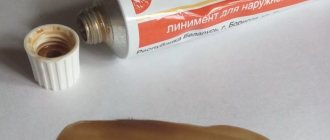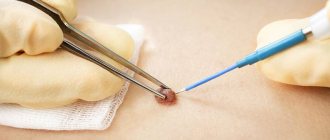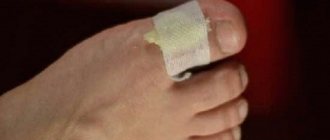Types of calluses
Callous formations are thickening of a small area of skin that occurs under mechanical stress. Such growths are divided into three types: wet, dry and bloody.
Dry
They are a keratinized layer of the epidermis, which has a yellow or gray tint and rises slightly above the surface of the skin. With such formations, a person does not feel pain, but over time, cracks appear on the thickening, which bring severe discomfort when walking.
Dry callus often appears after a soft growth has formed. But it can also form independently. This occurs due to prolonged moderate friction and pressure on the integument, which causes the area of the epidermis to thicken gradually rather than suddenly.
Wet
These calluses are distinguished by the fact that there is liquid inside them. It can be yellowish, transparent or bloody. Water tumors are always accompanied by unpleasant sensations, and therefore require special care and treatment.
If mechanical action continues to be applied to the wet bladder, then a dry callus will form in its place.
Bloody
Blood calluses on the toes are a separate type of skin neoplasm. They are similar to water bubbles, but inside there is not just liquid, but blood. They appear as a result of compression of the cover, near which a blood vessel is located.
Why are bloody blisters dangerous?
Ordinary calluses do not harm human health, but only cause discomfort when moving. But when the bladder is opened, there is a high probability that dirt will get into it, along with which an infection will penetrate. Pathogenic microorganisms lead to the development of the inflammatory process.
The greatest predisposition to adverse effects from calluses are people who suffer from vascular diseases, diabetes mellitus, and disorders of the nervous system. In such patients, even a small lesion of the skin can cause inflammation, during which the skin takes a long time to heal. Therefore, doctors advise that if you have such diseases, you should be especially careful about the skin of your feet.
Infection can be recognized by the following signs:
- Soreness in the affected area.
- Tugging callus.
- Redness and swelling of the skin.
- Increase in temperature in the damaged area.
- Cloudiness of the liquid inside the bubble.
If such symptoms occur, you should consult a doctor immediately.
What to do if the bubble bursts?
- treat the affected area and the skin around it with peroxide;
- pump out blood from the bladder;
- apply a bandage using an antiseptic or antibacterial agent;
- change the bandage every day until a hard crust appears;
- do not remove the skin covering the callus; it protects the wound from bacteria;
- do not treat wounds with alcohol or iodine solutions to avoid burns;
- keep the affected skin area sterile;
- When the first signs of infection appear—fever, purulent discharge or severe redness—seek medical help.
Reasons for the appearance of the tumor
The “culprit” for the occurrence of a bloody callus on the leg is the rupture of the blood vessels located in the affected area, as a result of which the resulting growth fills with blood. The following factors can provoke such an unpleasant process:
- Profuse sweating of feet.
- Constant friction of the skin.
- Lesions of the outer cover of a fungal nature.
- Failure to follow simple foot hygiene rules.
- Wearing shoes that are tight on the skin does not allow air to pass through well.
- Vitamin A deficiency in the body.
Prevention measures
To avoid the appearance of blood calluses, patients are recommended to constantly carry out their prevention. In this case, people need to carry out hygiene procedures daily.
To eliminate keratinized areas of the skin, special emollients are used. When choosing shoes, you need to ensure that they are as comfortable as possible.
Women are advised to alternate between high-heeled and low-heeled shoes. It is best to buy shoes made from natural materials that are fully breathable.
In summer, it is recommended to wear open shoes, which will eliminate the possibility of excessive sweating of the feet. If a person has excessive sweating of the feet, then it is necessary to combat it with the use of special medications.
Socks can cause scuff marks. That is why their selection should be carried out in accordance with size. When fungal diseases appear, it is recommended to treat them promptly.
For thin and sensitive skin, it is necessary to use a patch when wearing shoes for the first time.
Treatment methods
The doctor prescribes therapy depending on the degree of development of the pathology. At the initial stage of callus formation, patches, medications, and folk remedies are used, and at advanced stages, surgical intervention is used.
Medicines
The following medications are used to treat calluses:
- Salicylic acid. A cotton swab is soaked in it, applied to the affected skin and secured with a band-aid, and a sock is put on top.
- Streptocide ointment. Apply a thick layer to the callus, cover with cotton wool and apply a bandage. Leave it overnight.
- Hydrogen peroxide. This medication is highly aggressive, so it should not be used in the presence of open wounds, cracks, or scratches. Do not treat the damaged area with peroxide, but add it to the foot bath. The solution is made at the rate of 3 large spoons of medication per liter of water. Keep your feet in the bath for 10 minutes.
Folk remedies
Alternative medicine offers a huge number of methods to quickly deal with bloody calluses on the skin of the feet. With their help, there is an antibacterial, anti-inflammatory and healing effect.
Among the effective folk remedies are soap baths. You need to grate laundry soap and mix it with baking soda in a ratio of 1:3. Pour warm water into a bowl, add the resulting mixture there, stir until the components are completely dissolved. You need to keep your feet in the bath for about 30 minutes.
Another effective home remedy is a compress with garlic juice. A cotton swab is soaked in this substance, applied to the callus and bandaged. Leave it overnight. You can also use aloe: cut the leaf and apply the pulp to the callus before going to bed. Then the leg is bandaged. Keep the compress until the morning.
Removal
Thanks to modern medical methods, it is possible to treat bloody calluses easily and quickly, without resorting to radical methods. You can remove the tumor using the following operations:
- Laser. It is highly effective and safe. During the intervention, there is no need to puncture the callus, which helps prevent infection from entering it. The doctor focuses a beam on the growth, which burns the affected skin and removes the tissue. After this, the affected area is treated with a special ointment that prevents infection, and the leg is bandaged.
- Cryodestruction. This technique uses liquid nitrogen. Under its influence, the affected skin cells freeze and die. After a few days, a new healthy epidermis appears in place of the callus.
The indicated surgical methods for eliminating bloody calluses are considered the safest: after them, scars do not form, and relapses also do not occur.
How to speed up healing?
Following simple recommendations can help callus healing:
- If the callus is in a constantly injured area, limit friction (choose loose or open shoes).
- Cover the injured area with a clean bandage.
- If inflammation on the skin does not interfere with leading a normal lifestyle, do not pierce it.
- If the pain is severe, you can apply ice wrapped in a cloth.
If the callus bursts on its own, additional measures should be taken to reduce the risk of infection :
- do not remove the skin from the burst bubble, it additionally protects against dirt;
- wash the inflamed area with hot water and soap;
- you can take a foot bath with a weak solution of potassium permanganate;
- apply antibiotic ointment to the wound;
- apply a clean bandage;
- wash the wound several times a day;
- limit injury to the inflamed area.
Iodine or brilliant green can slow down the healing process of damaged skin . Use them only in cases where no other means are available.
Preventive measures
Bloody calluses not only bring discomfort and disrupt the aesthetic appearance of the feet, but also pose a danger to human health.
Therefore, you need to carefully monitor the condition of the skin. The following are recommended as preventive measures:
- Do not wear uncomfortable shoes that do not fit properly and are tight on the skin.
- Choose socks and tights without rough seams.
- Limit wearing high-heeled shoes or boots.
- Maintain personal hygiene of the skin of your feet.
- Treat shoes with disinfectants.
- Get rid of fungal infections of the skin in a timely manner.
The formation of a bloody callus on the feet is an unpleasant phenomenon that cannot be ignored. Only with proper treatment can you quickly get rid of skin pathology and avoid negative consequences.
How to get rid of it yourself?
It is no secret that most people, when calluses form, do not rush to see a doctor, but try to cope with the problem with improvised means.
How is a bloody callus on the foot treated and how to reduce pain? Let's look at the most common methods.
Plasters
If you have rubbed a callus, you can use a regular plaster , in which a hole is cut to the size of the formation. After gluing the patch, healthy skin receives protection from the action of medicinal medications that can cause burns.
A special preparation for the treatment of calluses is applied to the cut hole . Another patch is glued on top to prevent infection. The adhesive side should not come into contact with the blood blister to minimize the risk of damage.
Special plasters for the treatment of bloody calluses are much more effective.
They have a number of advantages compared to conventional adhesive strips:
- They stick firmly to the skin without coming off when they first get wet.
- Reduce pain.
- Accelerate healing.
- Reliably protect against infection.
Based on consumer reviews, the most popular patch that can really help with the formation of bloody calluses is Compeed from Johnson & Johnson . High quality, a wide variety of types of patches - and all this at a very affordable price!
Salipod also works well on calluses. Its price is affordable for everyone.
Ointments and creams
Still don't know what to do when you get a callus? Accelerate the healing of skin wounds by using ointments. They will reliably protect the skin from suppuration and speed up its recovery.
The ointments should be used for at least a week , remembering to apply a fresh bandage to the callus. The following remedies can be recommended:
- salicylic ointment;
- callus fluid;
- Karavaev balm;
- bensalitin ointment.
Creams for the treatment of calluses contain glycolic acid, vitamins and various oils. The acid will help soften the compaction and prevent further inflammation of the skin, and vitamins will accelerate regenerative processes.
Oils moisturize the skin and reduce discomfort. In order to achieve good results, the cream should be used for about ten days.
Folk remedies
Since calluses are a very common phenomenon, traditional medicine offers many ways to get rid of them:
- several cloves of garlic are infused with vinegar and applied to the inflamed area;
- ointment from celandine is applied to the formation on the skin ;
- grated raw potatoes are wrapped in gauze and applied to the site of inflammation;
- At night, a cut aloe leaf ;
- Fresh pine resin is applied to the callus and a patch is glued on top.
Possible consequences
Since any manipulation of the inflamed area threatens to damage the bladder, when treated with traditional methods, the risk of infection entering the wound increases significantly .
Remember that the release of pus indicates the beginning of a strong inflammatory process and requires medical attention . You should not experiment with your health - a small blood bubble can cause blood poisoning, which can lead to leg amputation or even death.










